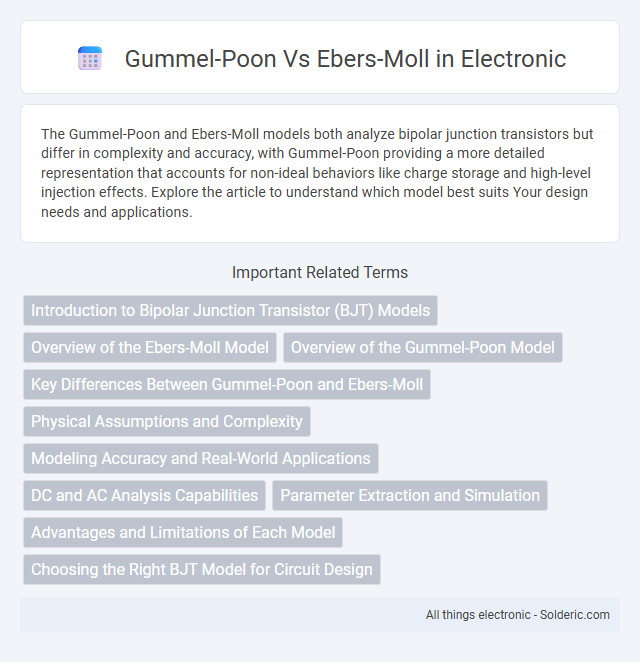The Gummel-Poon and Ebers-Moll models both analyze bipolar junction transistors but differ in complexity and accuracy, with Gummel-Poon providing a more detailed representation that accounts for non-ideal behaviors like charge storage and high-level injection effects. Explore the article to understand which model best suits Your design needs and applications.
Comparison Table
| Feature | Gummel-Poon Model | Ebers-Moll Model |
|---|---|---|
| Purpose | Accurate BJT behavior including high-level injection and charge storage | Basic BJT operation under forward and reverse active modes |
| Complexity | High complexity with multiple parameters | Simpler, fewer parameters |
| Application | Precision circuit simulation, nonlinear device modeling | Basic transistor analysis and large signal modeling |
| Current Components | Includes base charge effects, recombination, and carrier storage | Focuses on ideal diode currents in BJT junctions |
| Accuracy | High accuracy over wide operating range | Useful for approximate analysis |
| Parameters | Beta variations, saturation currents, capacitances included | Forward and reverse current gains (bF, bR) |
Introduction to Bipolar Junction Transistor (BJT) Models
Bipolar Junction Transistor (BJT) models like Gummel-Poon and Ebers-Moll are essential for accurately simulating transistor behavior in electronic circuits. The Ebers-Moll model provides a simplified representation focusing on the ideal current flow between emitter, base, and collector regions. In contrast, the Gummel-Poon model offers a more detailed and accurate description by incorporating base width modulation, high-level injection effects, and charge storage, making it suitable for precise circuit analysis and design involving your BJTs.
Overview of the Ebers-Moll Model
The Ebers-Moll model provides a comprehensive large-signal representation of bipolar junction transistors (BJTs), capturing both forward and reverse active operation through two coupled diodes and current sources. It accurately describes transistor behavior by relating emitter and collector currents to base-emitter and base-collector voltages with exponential functions based on the diode equation. This model is essential for analyzing BJTs in analog circuits, offering insights into DC and low-frequency performance, though it lacks the detail for high-frequency or non-ideal effects covered by more advanced models like Gummel-Poon.
Overview of the Gummel-Poon Model
The Gummel-Poon model extends the Ebers-Moll model by incorporating non-ideal transistor behavior, such as high-level injection effects and base-width modulation, to provide more accurate predictions of bipolar junction transistor (BJT) performance. This model uses a set of nonlinear equations that account for charge storage, recombination, and variable current gain, making it essential for precise circuit simulations in analog design. Understanding the Gummel-Poon model helps you analyze transistor behavior under varying operating conditions more effectively than the simpler Ebers-Moll model.
Key Differences Between Gummel-Poon and Ebers-Moll
The key differences between Gummel-Poon and Ebers-Moll models lie in their accuracy and complexity for transistor behavior. The Gummel-Poon model offers a more detailed representation, capturing non-ideal effects such as high-level injection and base-width modulation, which are not addressed by the simpler Ebers-Moll model. Your circuit simulations will benefit from Gummel-Poon's enhanced precision in predicting transistor performance under varying operating conditions.
Physical Assumptions and Complexity
The Gummel-Poon model incorporates the effects of base-width modulation and high-level injection, capturing more physical phenomena within bipolar junction transistors (BJTs) compared to the Ebers-Moll model, which assumes ideal transistor behavior with simplified current flow. Gummel-Poon introduces additional parameters to describe non-linearities and charge storage effects, increasing the model's complexity and accuracy in predicting real device performance under various operating conditions. Ebers-Moll remains simpler and computationally efficient, but lacks the detailed physical assumptions necessary for precision circuit simulations in advanced semiconductor applications.
Modeling Accuracy and Real-World Applications
The Gummel-Poon model offers higher modeling accuracy than the Ebers-Moll model by incorporating charge storage effects and high-level injection phenomena, making it ideal for precise transistor simulations in analog circuit design. Ebers-Moll provides a simpler, less computationally intensive approach suited for basic transistor behavior analysis and educational purposes. Your choice between these models depends on the application complexity and the need for simulation fidelity in real-world electronic device development.
DC and AC Analysis Capabilities
The Gummel-Poon model offers enhanced DC and AC analysis capabilities by accurately representing nonlinearities and charge storage effects in bipolar junction transistors (BJTs), making it ideal for high-frequency and analog circuit simulations. The Ebers-Moll model provides a simpler, idealized representation suitable for basic DC analysis but lacks detailed charge storage and frequency response modeling. Consequently, Gummel-Poon enables precise prediction of transistor behavior under varying operating conditions, while Ebers-Moll is limited to fundamental steady-state approximations.
Parameter Extraction and Simulation
The Gummel-Poon model offers enhanced accuracy in parameter extraction by incorporating high-level physical effects such as base-width modulation and charge storage, making it ideal for precise transistor simulation in integrated circuits. In contrast, the Ebers-Moll model provides a simpler, more intuitive approach with fewer parameters, suited for basic transistor behavior simulation but less effective in capturing complex dynamic phenomena. Simulation accuracy improves significantly with Gummel-Poon for advanced BJTs, while Ebers-Moll remains valuable for initial device modeling and educational purposes.
Advantages and Limitations of Each Model
The Gummel-Poon model offers enhanced accuracy in predicting transistor behavior by incorporating high-level effects such as charge storage and base width modulation, making it suitable for detailed circuit simulations involving bipolar junction transistors (BJTs). However, its complexity and computational intensity can limit its usability in large-scale or real-time applications where simpler models are preferred. The Ebers-Moll model, while less precise in capturing advanced transistor phenomena, provides a more straightforward and computationally efficient representation, making it advantageous for initial design stages or systems requiring faster simulation times, but it may lack accuracy in high-frequency or high-injection scenarios.
Choosing the Right BJT Model for Circuit Design
Selecting the appropriate BJT model is crucial for accurate circuit design and simulation. The Gummel-Poon model offers enhanced precision by accounting for high-level injection and base charge effects, making it ideal for RF and analog applications requiring detailed transistor behavior. Your choice depends on the complexity of the circuit; for basic switching circuits, the Ebers-Moll model suffices, while complex designs benefit from the advanced parameters in the Gummel-Poon model.
Gummel-Poon vs Ebers-Moll Infographic

 solderic.com
solderic.com